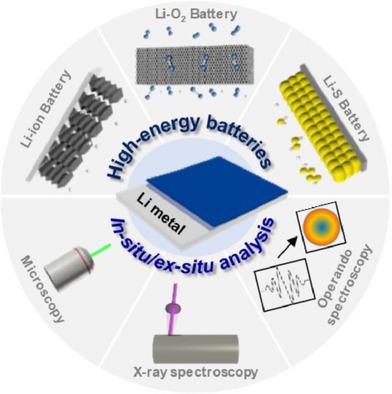当前位置:
X-MOL 学术
›
Batteries Supercaps
›
论文详情
Our official English website, www.x-mol.net, welcomes your
feedback! (Note: you will need to create a separate account there.)
Lithium Metal Interface Modification for High‐Energy Batteries: Approaches and Characterization
Batteries & Supercaps ( IF 5.1 ) Pub Date : 2020-03-27 , DOI: 10.1002/batt.202000016 Jung‐In Lee 1 , Gyujin Song 1 , Sungjin Cho 2 , Dong‐Yeob Han 2 , Soojin Park 1, 2
Batteries & Supercaps ( IF 5.1 ) Pub Date : 2020-03-27 , DOI: 10.1002/batt.202000016 Jung‐In Lee 1 , Gyujin Song 1 , Sungjin Cho 2 , Dong‐Yeob Han 2 , Soojin Park 1, 2
Affiliation

|
Rechargeable batteries have been a profoundly greater part of our lives than we could have ever imagined. The rechargeable Li‐ion batteries (LIBs) that have been developed for transport systems even put fossil fuels in the corner. However, state‐of‐the‐art Li‐ion batteries with graphite anodes are now approaching their theoretical specific energy limits, so they cannot meet the increasing demands of a range of portable electronics and large‐scale energy storage systems. Li metal is one of the most promising anode materials that could break through the energy density bottleneck of Li‐ion batteries due to its ultrahigh specific capacity and very low potential compared to other anode materials. Nonetheless, the direct use of Li metal in commercial battery systems has been hindered due to significant obstacles associated with it such as safety issues, corrosion from chemical reactions that occur inside the battery, or poor cycling performance. The fundamental reason for these problems is the dendritic growth of Li‐ions on the Li metal anode during cycling, as a result of the interfacial phenomena of Li metal and electrolytes. Modification of the Li metal interface with an electrolyte presents an efficient solution to solve these problems. In this review, the current challenges facing the development of Li metal anodes are presented in detail. The most recent advances in Li metal anodes using a controlled interface between the Li metal surface and an electrolyte are highlighted and an introduction on the synthesis and production methods for the application of high‐energy‐density battery systems such as Li‐oxygen (Li−O2), Li‐sulfur (Li−S), and Li metal batteries with high‐energy density cathodes is presented. Furthermore, the recent developments in the in situ/operando analysis tools adopted for the investigation of Li metal anodes such as the structural and chemical changes, dynamic properties, and solid–electrolyte interface (SEI) layer properties are described and summarized. Finally, some suggestions are given in the direction of the development of Li metal with artificial surface layers for use in future high‐energy batteries.
中文翻译:

用于高能电池的锂金属界面改性:方法和表征
可充电电池已成为我们生活中不可思议的重要部分。专为运输系统开发的可充电锂离子电池(LIB)甚至可将化石燃料置于死角。然而,目前最先进的带有石墨阳极的锂离子电池正接近其理论比能量极限,因此它们无法满足一系列便携式电子设备和大型储能系统不断增长的需求。锂金属是最有希望的负极材料之一,与其他负极材料相比,它的超高比容量和极低的电势可以突破锂离子电池的能量密度瓶颈。尽管如此,由于与锂金属相关的重大障碍(例如安全问题),阻碍了锂金属在商用电池系统中的直接使用。电池内部发生的化学反应引起的腐蚀或不良的循环性能。这些问题的根本原因是由于锂金属和电解质的界面现象,循环过程中锂离子在锂金属阳极上的树枝状生长。用电解质对Li金属界面的改性提出了解决这些问题的有效解决方案。在这篇评论中,详细介绍了锂金属阳极开发面临的当前挑战。重点介绍了在锂金属阳极中使用可控界面在锂金属表面和电解质之间的最新进展,并介绍了用于高能量密度电池系统(例如锂氧(Li- Ø 或自行车性能不佳。这些问题的根本原因是由于锂金属和电解质的界面现象,循环过程中锂离子在锂金属阳极上的树枝状生长。用电解质对Li金属界面的改性提出了解决这些问题的有效解决方案。在这篇评论中,详细介绍了锂金属阳极开发面临的当前挑战。重点介绍了在锂金属阳极中使用可控界面在锂金属表面和电解质之间的最新进展,并介绍了用于高能量密度电池系统(例如锂氧(Li- Ø 或自行车性能不佳。这些问题的根本原因是由于锂金属和电解质的界面现象,循环过程中锂离子在锂金属阳极上的树枝状生长。用电解质对Li金属界面的改性提出了解决这些问题的有效解决方案。在这篇评论中,详细介绍了锂金属阳极开发面临的当前挑战。重点介绍了在锂金属阳极中使用可控界面在锂金属表面和电解质之间的最新进展,并介绍了用于高能量密度电池系统(例如锂氧(Li- Ø 由于锂金属和电解质的界面现象。用电解质对Li金属界面的改性提出了解决这些问题的有效解决方案。在这篇评论中,详细介绍了锂金属阳极开发面临的当前挑战。重点介绍了在锂金属阳极中使用可控界面在锂金属表面和电解质之间的最新进展,并介绍了用于高能量密度电池系统(例如锂氧(Li- Ø 由于锂金属和电解质的界面现象。用电解质对Li金属界面的改性提出了解决这些问题的有效解决方案。在这篇评论中,详细介绍了锂金属阳极开发面临的当前挑战。重点介绍了在锂金属阳极中使用可控界面在锂金属表面和电解质之间的最新进展,并介绍了用于高能量密度电池系统(例如锂氧(Li- Ø2),具有高能量密度阴极的锂硫(Li-S)和锂金属电池。此外,描述并总结了用于锂金属阳极研究的原位/操作数分析工具的最新进展,例如结构和化学变化,动态特性以及固体-电解质界面(SEI)层特性。最后,针对在未来高能电池中使用的具有人造表面层的锂金属的发展方向,提出了一些建议。
更新日期:2020-03-27
中文翻译:

用于高能电池的锂金属界面改性:方法和表征
可充电电池已成为我们生活中不可思议的重要部分。专为运输系统开发的可充电锂离子电池(LIB)甚至可将化石燃料置于死角。然而,目前最先进的带有石墨阳极的锂离子电池正接近其理论比能量极限,因此它们无法满足一系列便携式电子设备和大型储能系统不断增长的需求。锂金属是最有希望的负极材料之一,与其他负极材料相比,它的超高比容量和极低的电势可以突破锂离子电池的能量密度瓶颈。尽管如此,由于与锂金属相关的重大障碍(例如安全问题),阻碍了锂金属在商用电池系统中的直接使用。电池内部发生的化学反应引起的腐蚀或不良的循环性能。这些问题的根本原因是由于锂金属和电解质的界面现象,循环过程中锂离子在锂金属阳极上的树枝状生长。用电解质对Li金属界面的改性提出了解决这些问题的有效解决方案。在这篇评论中,详细介绍了锂金属阳极开发面临的当前挑战。重点介绍了在锂金属阳极中使用可控界面在锂金属表面和电解质之间的最新进展,并介绍了用于高能量密度电池系统(例如锂氧(Li- Ø 或自行车性能不佳。这些问题的根本原因是由于锂金属和电解质的界面现象,循环过程中锂离子在锂金属阳极上的树枝状生长。用电解质对Li金属界面的改性提出了解决这些问题的有效解决方案。在这篇评论中,详细介绍了锂金属阳极开发面临的当前挑战。重点介绍了在锂金属阳极中使用可控界面在锂金属表面和电解质之间的最新进展,并介绍了用于高能量密度电池系统(例如锂氧(Li- Ø 或自行车性能不佳。这些问题的根本原因是由于锂金属和电解质的界面现象,循环过程中锂离子在锂金属阳极上的树枝状生长。用电解质对Li金属界面的改性提出了解决这些问题的有效解决方案。在这篇评论中,详细介绍了锂金属阳极开发面临的当前挑战。重点介绍了在锂金属阳极中使用可控界面在锂金属表面和电解质之间的最新进展,并介绍了用于高能量密度电池系统(例如锂氧(Li- Ø 由于锂金属和电解质的界面现象。用电解质对Li金属界面的改性提出了解决这些问题的有效解决方案。在这篇评论中,详细介绍了锂金属阳极开发面临的当前挑战。重点介绍了在锂金属阳极中使用可控界面在锂金属表面和电解质之间的最新进展,并介绍了用于高能量密度电池系统(例如锂氧(Li- Ø 由于锂金属和电解质的界面现象。用电解质对Li金属界面的改性提出了解决这些问题的有效解决方案。在这篇评论中,详细介绍了锂金属阳极开发面临的当前挑战。重点介绍了在锂金属阳极中使用可控界面在锂金属表面和电解质之间的最新进展,并介绍了用于高能量密度电池系统(例如锂氧(Li- Ø2),具有高能量密度阴极的锂硫(Li-S)和锂金属电池。此外,描述并总结了用于锂金属阳极研究的原位/操作数分析工具的最新进展,例如结构和化学变化,动态特性以及固体-电解质界面(SEI)层特性。最后,针对在未来高能电池中使用的具有人造表面层的锂金属的发展方向,提出了一些建议。









































 京公网安备 11010802027423号
京公网安备 11010802027423号